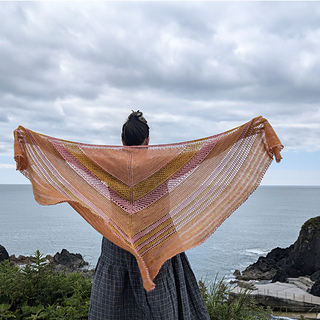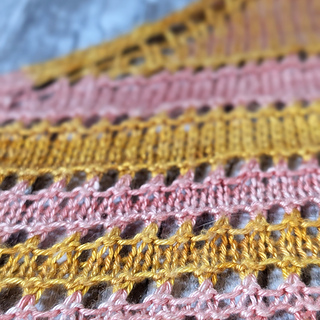patterns >  An Caitin Beag Ravelry Store
An Caitin Beag Ravelry Store
> Sun Stop shawl
















Sun Stop shawl
The Sun Stop Shawl is a lovely exploration of texture and stripe. There are sections of yarn-contrast colourwork where we mix the floof and silk, patches of daisy stitch and geometric openwork, and eyelet stripes, and it’s finished with a fluffy hem and pretty picots.
It’s fun to knit, too - the pattern switches often enough to keep you engaged, and each section itself is a fairly straightforward knit. The last section, with those subtle fluffy stripes, practically knits itself. (And, ok, the picot bindoff might generate a few swears, but it is absolutely worth it.)
My working-name for this shawl was EPIC, and the shawl does not dsappoint. The finished blocked shawl measures 240cm from tip to tip, and is 115cm deep along the spine.
Yarn
Two shades of Yarn A
100gr/ 400 metres of a 4-ply yarn in each colour.
Two similar or identical shades in Yarn B
50gr/ 400 metres of a light and fluffy lace-weight yarn in each colour.
You want a contrast in texture between the two yarns. Look for something strong and lustrous for yarn A - a silk or silk-blend yarn is perfect, but tencel or mercerised cotton could also work well.
For yarn B you’re looking for fluff! Mohair is perfect, but a brushed suri alpace would also work well.
I used Caitin Silk (100% silk) for yarn A, and Caitin Fluff (68% mohair, 32% silk) for yarn B, in the colourways Peony (shade one) and Honey Honey (shade two). Kits for this shawl are available here.
Colour choices
When choosing your colours look for two that will look good both striped and blended together. Combinations of similar-hued light and dark yarns will work well, as will shades that are not too far apart on the colour wheel.
It can be useful to imagine that the yarn is paint, and to picture what colour you’d end up with if you mixed the two.
Any two primary colours should mix well - like the pink and yellow I’ve used - as should any primary with its neighbouring secondary shades. Two secondary shades may work well but there’s a bit more potential for muddiness. Opposing colours - red with green, for example - will probably work up dull and a little muddy in the fluff sections (although the stripes will pop).
9 projects
stashed
9 times
11 projects
stashed
14 times
- First published: June 2024
- Page created: June 24, 2024
- Last updated: July 12, 2024 …
- visits in the last 24 hours
- visitors right now




